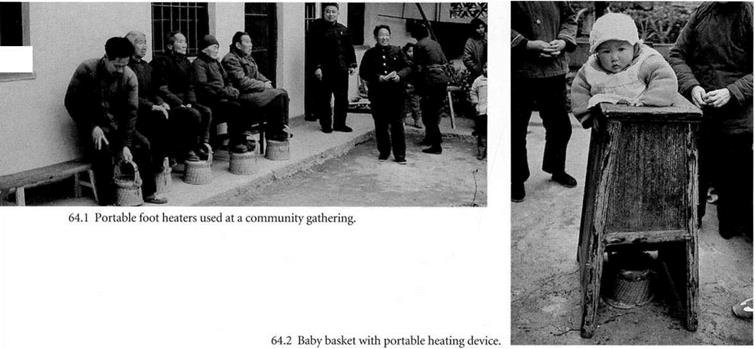A lean-to, sloping roof projects from the exterior of the high outer retaining wall that surrounds the living area of
 |
Huizhou dwellings. Beneath this roof are housed the chufang (kitchen), shaichang (containing the laundry area, clotheslines, well, etc.), vegetable gardens, livestock pens, and toilet; this entire area is bounded on the other side by another high retaining wall. This roofed, walled area is independent from the living area, giving the living space proper a double-wall construction.
Skylights are the main source of lighting for the chufang, with supplementary light provided by small windows cut into the walls at strategic locations. The sunlight that filters in effectively lights the dim, earthen-floored space (Figure 63.1).
Thp cpntrnl fortturp of thp rhufiing ie fhp cfAVP. which ie constructed of mud. The mortar-covered flues are inscribed with decorative motifs and with prayers for the family’s welfare (Figure 63.2). Coke is the primary source of fuel, supplemented by wood and brush. An additional charcoal brazier is often set beside the stove. Cupboards are small and tableware is simple and minimal, strikingly different from the tremendous variety of tableware used in Japanese dining.
There is no designated bathing room in the Fluizhou
dwelling. Washbasins are used for daily washing and public bathhouses are widely available throughout the cities.
Furnishings
Cabinetry and furniture is extremely simple. Chests are used mainly to store clothing, and these are gradually being replaced by Western-style wardrobes. Chests of drawers are rarely seen.
Sideboards are made of bamboo or wood with screening on the upper portion and slatting on the lower portion. This style is unchanged in old and more recent pieces. Overall, there is a very large drop in quality between
traditiAnpl ("hitipep ftnp игллгі fiirnitm-p in the Міпд япЛ
Qing styles and everyday furniture. No such drop in quality, however, is seen in Chinese handicraft utensils, for which such materials as wood, bamboo, ceramics, and bronze are used.
There is no built-in heating equipment. Portable, basket-like charcoal-burning foot warmers made of bamboo are hung from the arm when carried (Figure 64.1). Baby baskets are also frequently equipped with similar heating devices (Figure 64.2). Such individual heaters and quilted

clothing are essential to withstand the severe winters of the Anhui region.
dom from the confines of the Confucianist system, the community has torn down the old walls and is building a new compositional framework around a new courtyard.



